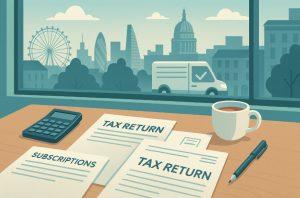In the UK, many employees are required to pay annual fees or subscriptions to professional bodies in order to practise in their field or maintain industry recognition.
What many don’t realise is that these costs can often be reclaimed through HMRC as tax relief. Whether you’re a teacher, solicitor, doctor, or engineer, understanding how tax relief for employees professional fees and subscription works can lead to significant financial savings. This guide explores who qualifies, which costs are eligible, and how to claim your entitlement effectively.
What Is Tax Relief on Professional Fees and Subscriptions in the UK?

Tax relief allows employees to reduce their taxable income by claiming back certain job-related expenses. In the UK, one of the most commonly overlooked yet beneficial forms of tax relief relates to professional fees and subscriptions. For many professionals, maintaining membership in industry-specific organisations is not just a matter of prestige but a requirement of their job.
From healthcare and law to education and engineering, employees across various sectors often pay annual subscriptions to professional bodies. These payments, if made by the individual and not reimbursed by an employer, can be reclaimed through HMRC approved tax relief schemes.
Which Types of Professional Fees and Subscriptions Qualify for Tax Relief?
Not every subscription or fee qualifies. HMRC stipulates that the payment must be “wholly, exclusively and necessarily” incurred as part of your current employment. This means that if the subscription directly relates to your job and is required for you to carry out your duties, it’s usually eligible.
Eligible fees typically include:
- Membership of regulatory or governing bodies (e.g. Medical Council)
- Trade union subscriptions (in some cases)
- Professional society memberships required for legal practice, continued education or technical licensing
Subscriptions that enhance general career prospects but aren’t essential to your current role usually won’t qualify. For example, a software engineer subscribing to a design journal unrelated to their current duties wouldn’t be eligible.
What Is HMRC’s List 480?
HMRC maintains an official document known as List 480, which is a comprehensive list of approved professional bodies and learned societies. Only the memberships listed in this document are eligible for tax relief.
Before making a claim, employees must check whether the organisation they’ve paid a subscription to is included on this list.
Examples of HMRC Approved Bodies
- British Medical Association (BMA)
- Institute of Chartered Accountants in England and Wales (ICAEW)
- Royal Institute of British Architects (RIBA)
- General Teaching Council
- National Education Union (NEU)
- Law Society
These bodies often require professionals to maintain active memberships to stay certified or compliant in their respective industries.
Why It’s Crucial?
If the body is not on List 480, even if it seems relevant to your job, HMRC will not allow the tax deduction. This makes checking the list a vital first step before submitting any claim.
Who Can Claim Tax Relief on Professional Subscriptions?

Eligible Professions
Professionals from a wide range of sectors are eligible to claim tax relief on subscriptions, especially if those memberships are required for them to perform their job roles. The most common include:
Healthcare Workers
Doctors, nurses, paramedics, and allied healthcare professionals often pay to remain on professional registers or belong to unions. These fees are often recoverable.
Legal Professionals
Solicitors, barristers, and legal consultants who are members of legal societies or councils can generally claim relief on their membership dues.
Educators
Teachers registered with teaching councils or members of unions like the NASUWT or NEU are often eligible.
Engineers and Architects
Many engineering roles require memberships to organisations like the Institution of Civil Engineers or the Institution of Mechanical Engineers.
Finance and Accounting Professionals
Chartered accountants and tax advisors, such as those associated with ICAEW or ACCA, regularly claim tax relief on required subscriptions.
Union and Trade Memberships
While not all trade unions qualify, many that are considered essential for collective bargaining or job protection within regulated industries may be eligible.
How Can Employees Claim Tax Relief on Subscriptions and Fees?
There are two main routes to claiming tax relief:
1. Using Form P87
Ideal for employees who are taxed under PAYE and have allowable expenses under £2,500 for the tax year. This form can be submitted online via your Government Gateway account or by post.
2. Through Self-Assessment
If you already complete a self-assessment tax return (common for higher earners or those with multiple income sources), you can add your professional fees to the employment section of your tax return.
Supporting Evidence
You’ll need to retain the following:
- Payment receipts or invoices
- Evidence of the necessity of the membership for your job
- Employer statements (if relevant)
Backdating Claims
HMRC allows claims for up to four previous tax years, meaning if you forgot to claim earlier, there’s still time to get reimbursed.
How Much Can You Save with Tax Relief on Professional Fees?
The actual savings depend on your income tax band and the amount you’ve paid in eligible fees. The tax relief you receive equals the rate of tax you pay multiplied by the cost of the subscription.
Savings Breakdown Table
| Annual Subscription Fee (£) | Basic Rate (20%) Taxpayer – Relief (£) | Higher Rate (40%) Taxpayer – Relief (£) |
| £100 | £20 | £40 |
| £250 | £50 | £100 |
| £500 | £100 | £200 |
| £1,000 | £200 | £400 |
For a basic rate taxpayer paying £250 per year in professional fees, claiming could result in a £50 refund every year.
Why It Matters?
Many professionals are unaware they could be entitled to hundreds of pounds annually. Over multiple years, unclaimed tax relief can add up to significant amounts.
What Are the Most Common Mistakes When Claiming Professional Fees Tax Relief?

One of the most frequent mistakes employees make is attempting to claim tax relief for subscriptions to organisations that are not approved by HMRC. Even if the membership feels relevant to your profession, it won’t qualify unless the organisation is listed on HMRC’s List 480.
Another common error involves mixing personal and professional costs. HMRC requires that any claimed expense be entirely job-related. If your subscription includes personal benefits such as access to a gym or general-interest publications. it may be disallowed during review.
Filing the claim incorrectly is also a major pitfall. Some employees mistakenly use Form P87 when they should be filing through a self-assessment tax return, especially when their work expenses exceed the £2,500 threshold. Using the wrong method can lead to delays or even rejection of the claim.
Finally, many individuals fail to keep proper receipts or payment records. Although HMRC doesn’t require evidence at the time of submission for smaller claims, they may request proof later. If you can’t provide valid documentation, your claim could be denied or result in penalties.
Why Should Employees Take Advantage of Tax Relief on Professional Costs?
Professional subscriptions are often a necessary part of career development, legal compliance, and maintaining certification. However, the costs can become significant over time.
By claiming tax relief for employees professional fees and subscription, workers can legally recover part of these expenses, effectively reducing their annual tax bill. Given the relatively straightforward claim process and potential for backdating, employees in London and across the UK should regularly review their eligibility and make the most of this opportunity.
Failing to do so means leaving money on the table money that could be reinvested into your career, training, or even simply saved for the future.
Conclusion
Claiming tax relief for employees professional fees and subscription is a smart way for UK professionals to reduce their tax burden. If the fees are essential for your job and the organisation is HMRC-approved, you may be entitled to claim back a portion of the cost. With simple claim methods and the ability to backdate up to four years, it’s an opportunity well worth exploring.
Resource
FAQs About Claiming Tax Relief for Subscriptions
Can I claim tax relief if my employer already reimbursed me?
No. Tax relief is only available if you personally paid the fee and were not reimbursed by your employer.
What if the subscription benefits both my job and personal development?
Only the portion directly tied to your current employment is eligible. Dual-purpose costs are generally disallowed.
Do I need to submit receipts with my claim?
No, but you must keep evidence of payment in case HMRC requests it later.
Can I claim tax relief on past years’ fees?
Yes. HMRC allows claims going back up to four tax years, provided you have proper records.
What happens if I claim a non-approved body by mistake?
HMRC will deny the claim and may delay processing your return. Repeated errors could trigger audits or penalties.
Can I claim for two or more professional memberships?
Yes, if all are approved by HMRC and required for your current role.
Is there a deadline for claiming tax relief on subscriptions?
Yes, claims must be made within four years of the end of the tax year in which the fee was paid.









Leave feedback about this